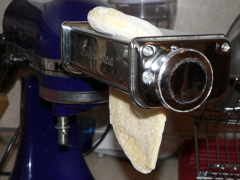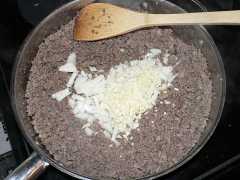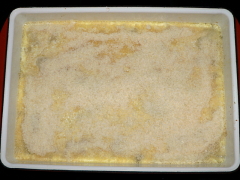This week was going to be ravioli, but I had a lot of mozzarella left after last week’s chili-cheese fries. I mentioned to my wife that I’d have to figure out something to put it in, and she suggested I do a lasagna.
Now I had already done that once before. But I wasn’t thrilled with how the top came out, because I neglected to cover it for the first half-hour. So this would be my chance to fix that.
But as we were talking about it, my wife mentioned a white lasagna that she used to make in college that everyone thought was great. Figuring that [WARNING: impending understatement!] college students aren’t always the most reliable food critics, I decided to look for some recipes.
Wow, there’s a lot of them.
There were quite a few that had a white wine sauce, with or without mushrooms. Bunches that had chicken stock. Lots with spinach or peas or other greens in them. But I wanted to go simpler than that. So what follows is an experiment that mostly came out just how I wanted. There are only a couple changes I will make the next time.
Ingredients
cheese filling
1 lb ricotta
1/2 lb mozzarella, shredded
1/2 lb provolone, shredded
2 cups heavy cream
1/2 stick (4 tbsp) butter [see note below]
4 large eggs
meat filling
1-1/2 lb ground beef
1/2 lb Italian sausage
1 medium onion
4 cloves garlic
2 tbsp basil pesto
salt and pepper
pasta
1 cup flour
2 large eggs
2 tsp kosher salt
topping
1 cup Parmesan, grated
Directions
The noodles
Start by making the pasta as shown in the previous entry. Roll out the noodles using a pasta roller.
I ended up with eight sheets of pasta, roughly 6 inches wide by about 9-12 inches long, using setting 7 of 8 on my roller. Since I would need three layers about 9 x 13, this is plenty to cover everything with a little overlap, and still have a bit left over. Set all the noodles aside and start on the meat.
The meat
Brown the ground beef and sausage together in a large frying pan with salt and pepper.
While that is going, dice the onion fine and mince the garlic. Once the meat is well browned, drain it very well. The meat needs to be very nearly dried out before baking, or the end result can be soggy. Don’t wipe out the pan, though. You’ll need just a little fat to sauté the onion and garlic.
Return the meat to the pan, make a space in the center, and add the onion and garlic.
Cover the onion and garlic with meat and cook over low heat for a couple of minutes. Then mix everything and sauté until the onion turns clear. When the onion is finished, add about a quarter cup of water to the pan to deglaze. Don’t measure it, just put in enough to barely cover the bottom of the pan. Scrape everything up with your spoon or spatula, and toss everything well. This step adds an amazing amount of flavor back into the meat.
Add the pesto and mix well. Keep it over low heat and stir occasionally until the water has steamed off and the bottom of the pan is dry again, then remove from heat.
The cheese
Melt the butter and pour it into a mixing bowl. You can do this by hand, but I prefer the stand mixer. Add the ricotta and break it up well with a spoon or the mixer.
Add the cream and eggs and blend well on low to medium speed. You don’t want to whip the eggs into a meringue.
The assembly
Make a work space where you can put the meat, cheese filling, two bowls of shredded cheese, and lasagna pan all together.
Using a ladle, put enough of the cheese mixture in to cover the bottom of your pan.
Pay attention to how much you need for this step. Scoop the same amount, plus half, into a separate bowl and reserve for the top layer. (With practice, you’ll be able to gauge this without reserving any.)
Cover the bottom of the pan with a single layer of noodles. You want the edges to overlap a little bit so they’ll stick together when they bake.
Notice that I had to cut several pieces to fill the whole pan. It won’t make a difference in the final product as long as you have a good overlap.
Now scoop half the meat into the pan.
Spread it around evenly, then add half the remaining cheese sauce — assuming you’ve reserved some for the top layer — over the meat.
Top with either the mozzarella or the provolone cheese. (I did the mozzarella first, not that you can tell in the pictures.)
Add a second layer of noodles.
For the second layer, I used a different method for loading the fillings. Simply add the cheese sauce into the meat and mix well. Don’t scrape the mixing bowl to get every last bit. You’ll see why shortly.
Spread this mixture evenly over the noodles.
I tried both ways to compare, and can say that without a doubt this second method is much easier to work with.
Top this with the remaining cheese — mozzarella or provolone.
Then one last layer of noodles. Try to make this layer as flat as possible so the cheese sauce covers evenly.
Scrape the bottom of the mixing bowl to get the last chunks of ricotta. (I told you I’d come back to it.) Use these to plug gaps between the edges of the noodles and the pan so the sauce doesn’t all run down. Cover the top layer of noodles with the reserved cheese sauce.
Cover the pan with aluminum foil and bake at 350° for 30 minutes.
I had some pasta left over. While the lasagna was in the oven, I sliced the extras into thin noodles and boiled them up. Add a little butter and give the girls a quick snack while they waited.
After 30 minutes, remove the foil …
… and top with the Parmesan.
Place under the broiler until the Parmesan is bubbling and starting to turn brown in spots.
This could take several minutes or could be less than 30 seconds, depending on how hot your broiler gets and how close you put the pan.
Remove the pan and allow to cool for 15-20 minutes before slicing. If the cheese inside is still too liquid, the slices will slide apart as you serve them. Still great taste, but not so great presentation.
Next time
I made this with a whole stick of butter. Next time I’ll cut that in half. When I removed the foil to add the Parmesan, there was quite a bit of butter bubbling up around the edges of the top layer of noodles.
Also, after deglazing the pan with the meat filling, I didn’t cook off enough of the water. For my next lasagna I’m going to try piercing a few holes in the foil to allow more steam to escape.


































